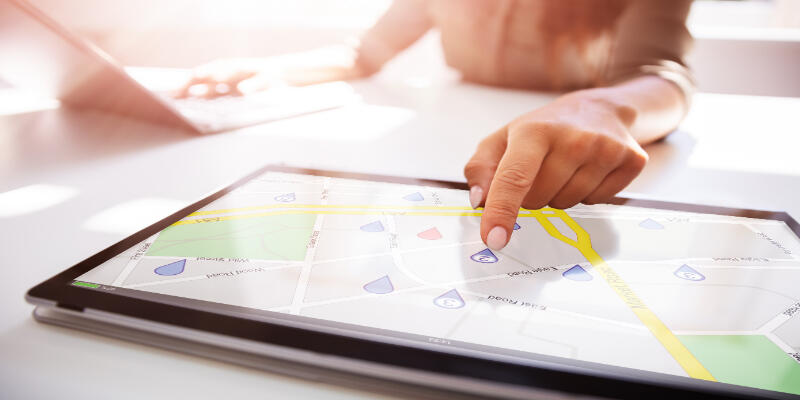Disclaimer: This post may contain affiliate links, meaning we get a small commission if you make a purchase through our links, at no cost to you. For more information, please visit our Disclaimer Page.
Nowadays there are many tablet brands and models. Some are cheaper, some are more expensive with lots of different features. One of the most popular features is Global Positioning System or GPS. More and more people demand that GPS be one of the most important criteria when buying tablets. So how can you tell if a tablet has GPS?
The best way to tell if a tablet has GPS is to download and run a GPS satellite app. It will show you where all the satellites are at any given time because mapping applications that show your location are not proof that your device actually has GPS.
This is not the only answer to your question, but it is the most accurate. GPS is one of the things in life if not a necessity that makes things easier.
There are a few more ways to determine if your tablet has GPS.
In this article, I will explain which are alternative ways, how to enable GPS on your Android tablet, and what are the major differences between cellular and Wi-Fi-only tablets.
Table of Contents
Do tablets have GPS built-in?
Most tablets now have GPS. If it’s a cellular connection tablet, it will have a built-in GPS feature because cellular networks use GPS for timing. Android tablets use a GPS sensor for location-based apps like maps, browsers, and cameras.
Built-in means the circuitry of the GPS receiver and its antenna are factory-installed inside another piece of hardware in your tablet.
The GPS is part of the modem chip. GPS chips are small, approximately 20mm, and they are usually attached to the device’s motherboard or in a slot on the motherboard.
There is also a connected GPS. The major difference is that the connected one should be connected to a tablet. It’s connected mostly via Bluetooth but that is a rare setup. The connection is unstable and not as accurate as the built-in GPS.
The increased demand for tablets containing GPS is because GPS navigation devices have become very expensive and unprofitable. And with these navigation devices, area maps are not updated automatically, but you must pay extra for each update and upgrade.
Tablets with built-in GPS are much more cost-effective. With them, maps are updated automatically through software updates, they are much cheaper than classic navigation, and you can read emails, surf, and even make phone calls if you have an LTE version of the tablet.
Connecting an external GPS antenna is possible if your tablet doesn’t have GPS. The process itself is not complicated, but when working with various GPS gadgets, you can encounter problems.
Some problems are a weak GPS signal or its complete absence so I would not recommend it.
Besides the tablets having much more powerful processors, their battery life is significantly longer than GPS navigation devices.
It should be emphasized that the GPS systems in the tablets are not intended for precise use because they still rely on locating positions using mobile and Wi-Fi networks.
GPS is actually an American system developed for the military, however, its version is used in civilian use.
In addition to America having its own, other countries have it, too! Russia’s global positioning system is GLONASS, the European Community Galileo, and China Beidou.
How to tell if a tablet has GPS?
First, the easiest way to find out if your tablet has a GPS is definitely to carefully look at the specifications of the device. In the specifications, a feature like GPS should be emphasized. Besides the specifications, the user manual definitely states whether the device has a GPS.
The above claims apply to the device before you buy it. But what if you get a tablet as a gift?
Here, it’s best to check and find Locations in Settings. If your tablet has GPS, there will be a location that needs to be turned on, usually labeled Location ON or Location Enabled.
This allows GPS to work and your location to be transmitted back to the server so that real-time navigation can work.
If your tablet contains a map app, it still doesn’t mean for sure that it has a built-in GPS. The safest way to provide more information about a GPS is to download an application such as GPS Status & Toolbox which besides analyzing existing GPS, also provides information directly from the sensor on signal strength, quality, and speed.
Aside from these simple steps, I have also found one for tech enthusiasts. You can also check the GPS status on your tablet via codes that will give you access to the advanced menu of the device’s operating system.
First, launch the Phone app and open the keyboard as if you are going to type a phone number.
Depending on the device model you have, several codes are typed. Type the code * # * # 4636 # **. Try code * # 0 * # or # 7378423 # **if that code doesn’t work.
Once you have accessed the operating system menu, select the item related to the GPS status and the diagnostics will be performed. The codes vary because of different models of tablets.
It is important to say that some of these steps work only on Android 11 and up so make sure you have the latest version of the software on your tablet. The same thing applies to different tablet models.
How to enable GPS on your Android tablet?
GPS is called Location services on Android devices. It is a very useful system for many things other than specific navigation and finding your location on a map. Most Android apps require you to turn on Locations on your tablet.
GPS determines your location with extreme accuracy and allows you to share your location with friends and family or you can find out which is the best restaurant nearby.
Games such as Pokemon Go constantly require the use of GPS while playing.
When you open such an application, it should immediately alert you in case the GPS is turned off and it will take you directly to the settings where you should enable GPS.
However, if you want to enable GPS on your initiative, you can do it in these two ways.
Turn on your tablet and come to the Home screen. Swipe from top to bottom and you will see the notifications bar. If you have Quick settings set, find Location or GPS. When you find an item, tap and GPS should turn on.
If you don’t have a Location in Quick Settings, we’ll turn on GPS a little longer. Turn on the tablet and go to the Main Menu. Find Settings. When you enter Settings, we need to find the section where the Location or GPS is located.
Since some Android devices differ, look for the Location or Privacy sections. When you find a Location, you must enable it. And that’s it, GPS is on!
After using GPS, I recommend turning it off. There is no need to constantly work in the background as it consumes more power than other popular apps, draining your tablet’s battery much faster.
You can also do it for privacy reasons if you would rather not let apps know where you are. Keep in mind that some apps might not work correctly in that case. Always check why an app wants to know your location and decide if it’s worth sharing.
Do Wi-Fi Only tablets have GPS?
We acknowledged the fact that there are tablets with different connections to the internet. There are cellular tablets, Wi-Fi tablets, and a combination of both.
The major difference is that with a cellular model and a data plan you get full internet access anywhere without needing to stay in the range of Wi-Fi. Wi-Fi-only tablets don’t have a SIM card slot. With a SIM card, you can make calls as well.
The cellular connection is faster than broadband in large city areas. It depends on cellular coverage and that can be tricky in rural areas.
Wi-Fi-only tablets have GPS, but there are a few exceptions such as Wi-Fi-only Apple iPads. Before buying a tablet I suggest reading the specifications of the device. I will provide information about the differences between the models.
The GPS receiver can use GPS without cellular connectivity but it will take longer to acquire data. The cell tower speeds up position fix by providing precise time and information. Wi-Fi-only tablets have to track and wait for satellites to transmit data. That takes a bit more time.
Most tablets have GPS regardless if they are cellular or Wi-Fi-only. The GPS capabilities are not conditioned with the type of internet connection. In reality, most tablet chips contain Bluetooth, Wi-Fi, and GPS altogether.
Wi-Fi-only tablets are cheaper than cellular models but there is no point in owning a cellular tablet without a data plan. Over some period of time, you will pay double the price of a Wi-Fi-only model because of the data plan fee.
The advantage of cellular models is convenience. As long as you’re in the area with good network coverage you will have a stable and fast connection. Cellular connection serves as a backup, meaning tablets will connect to Wi-Fi first if available.
I should mention that the battery life in cellular tablets is shortened significantly. The constant connection to 4G drains a lot of battery, but location services are more efficient on tablets connected to the mobile network. The cellular network retrieves data quickly and can provide an exact location faster.
All things considered, the tablet’s connectivity should not be the most important characteristic when buying one.
Conclusion
Most tablets nowadays have a built-in GPS, however, if this is really one of the most important items for you, check just in case. The presence of mapping sites is not a sure indicator that the tablet has GPS so pay attention to that.


